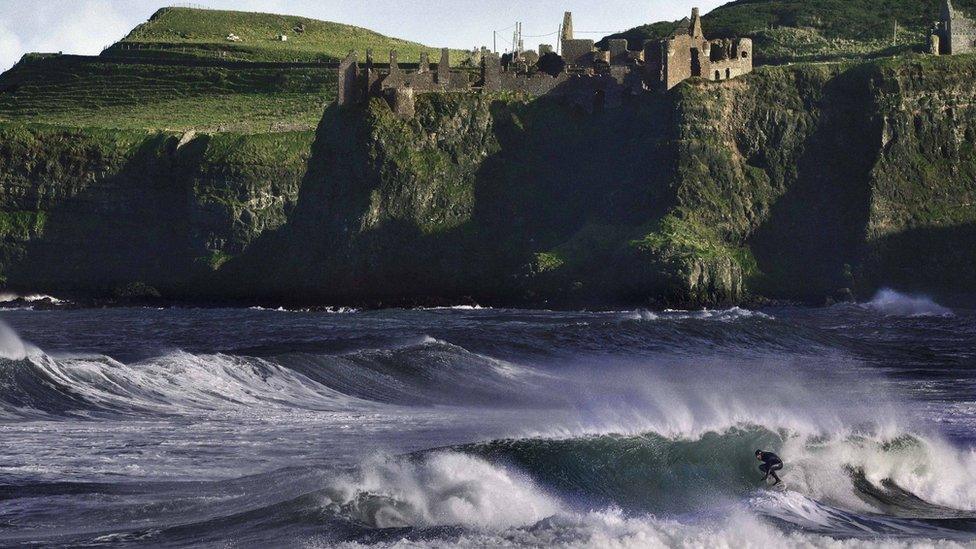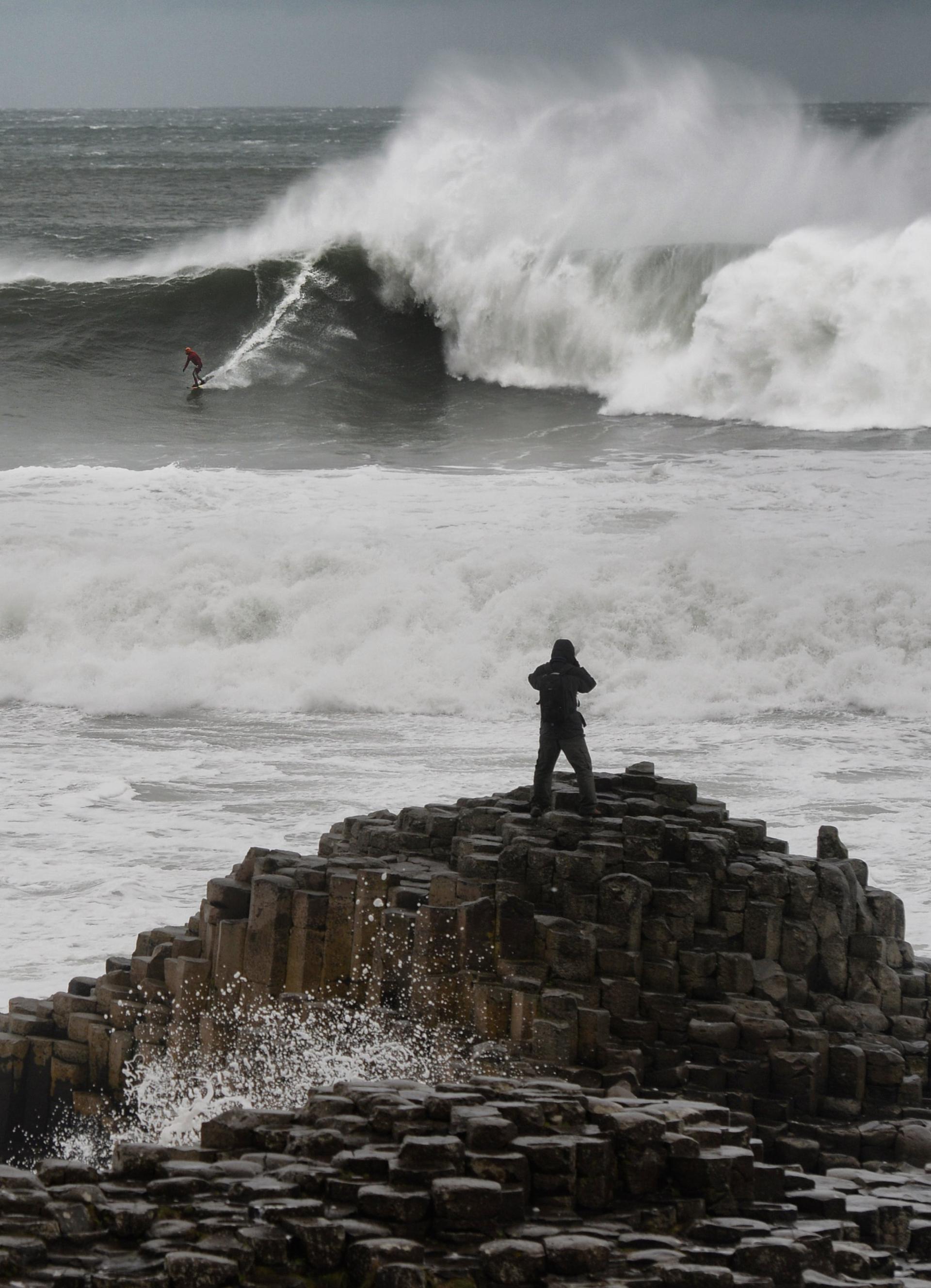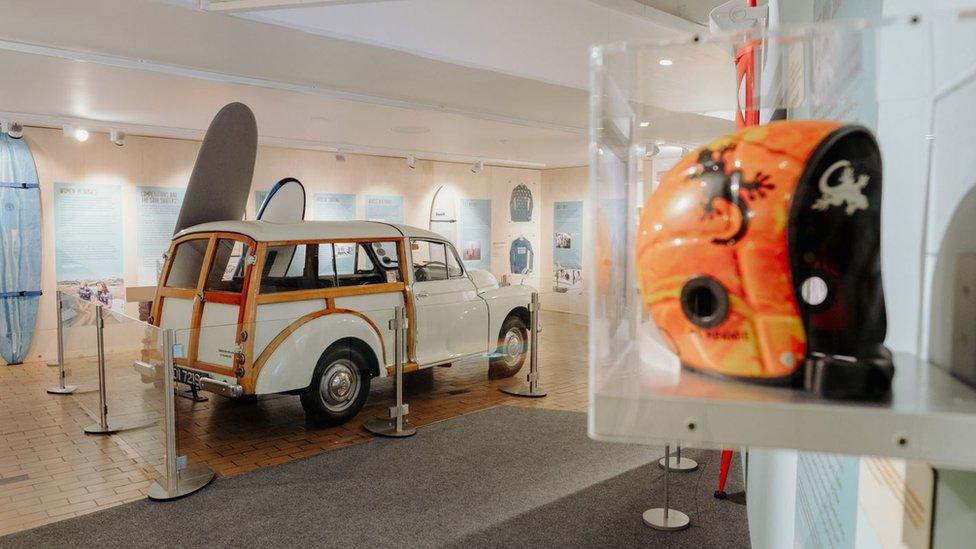Surfing exhibition dives into Ireland's love of big waves
- Published

Al Mennie - pictured surfing off County Antrim's Causeway Coast - is one of Northern Ireland's best-known surfers
Northern Ireland has become an increasingly popular destination for those who love to surf.
The north coast's exposure to swells from the North Atlantic Ocean in particular creates perfect conditions for those wishing to catch waves.
The island of Ireland's connection with the sport began in the 1960s and has grown steadily since.
Now surfing's story in Ireland is being explored in a new exhibition at the Ulster Transport Museum in County Down.
Celtic Wave, the first new exhibition at the Holywood museum in over a year, includes a collection of specially curated items and interviews from some of the most talented surfers, sharing their passion for the sport.
One surfer is Al Mennie, 41, who began surfing with his brother at the age of seven in the seaside village of Castlerock on the County Londonderry coast.
At that time surfing was still such an unusual sight in the area that the pair were known locally as "the surfers".

Ulster Transport Museum curator Clare Ablett and Al Mennie have come together to help produce the exhibition
But things have changed since then.
"Surfing is a household name now," he said.
"You can go to the popular supermarkets and buy a paddleboard, for example, some of them sell surfboards, you can get wetsuits too.
"Everyone now can access surfing fairly easily and fairly inexpensively."
Big-wave surfing
Al began competing in events across Ireland and in the UK but his pursuit of some of the biggest waves in the world is how he really made a name for himself.
Known as big-wave surfing, it sees experienced surfers towed into huge swells as high as 60ft (18m) or, as Al describes them, "as big as houses".

The north coast is a hugely popular destination for surfing
Traditionally surfers travelled to places like California for big-wave surfing but Al was one of the first to tackle the huge waves found off the coast of Ireland.
He said: "I borrowed money, bought a boat and went off the coast here to find those locations, to surf them, as I still do today.
"Some of the biggest waves in the world exist here. On the west coast of Ireland I've surfed 60ft waves."
Serious wipeout
One of the items on display in the exhibition is a helmet worn by Al which shows just how dangerous big wave surfing can be, even for experienced surfers.
While surfing a 40ft (12m) wave at Mullaghmore Head, County Sligo, Al came off his board - known in surfing as a "wipeout".
"I decided to step off the board because I felt that if I didn't step off the board the wave was going to land on me and probably put me through my board," he said.
As he was thrown around beneath the wave, he felt something hit his helmet with such force it caused the helmet to crack.
He came away with concussion but had he not been wearing the helmet his injuries could have been much worse.

Photographers often brave the elements to capture shots of Al Mennie as he surfs close to Northern Ireland landmarks such as the Giant's Causeway
Despite that, Al said accidents have been a rare occurrence for him while surfing big waves.
"You're constantly prepared for the worst-case scenario and you've got multiple guys ready to do rescues," he said.
"I'm very highly trained and experienced so I'm always ready for the eventuality that something goes wrong and often it doesn't because we're so overprepared most of the time.
"Probably one of the things that keeps me hooked on it, I suppose, is the risk involved in it."
Some of the pioneers of surfing across the island of Ireland are also the focus of the exhibition.
It features an interview with Kevin Cavey, known affectionately as the grand-daddy of Irish surfing.
He worked to popularise surfing in the 1960s after reading an article about the popularity of the sport in California.
He went on to set up the Surf Club of Ireland and put on a display at the Dublin Boat Show in 1966.

The 1970 Morris Traveller has become synonymous with surfing
At the same time along the north coast, surfers like Bo Vance, Davy Govan and Martin Lloyd were introducing the sport to Northern Ireland.
Clare Ablett, history curator at National Museums NI, said: "We did interviews with surfers across Ireland because we wanted to capture the story in their own words because there's really not been very much written about it.
"A lot of people aren't aware that we have a big surf scene here in Ireland so it was important we have these interviews to give insights which we wouldn't have been able to gain in any other way but also they could tell it in their own words."
Visitors to the exhibition can see surfboards designed by locals, including a replica of one used by Al which is 11ft 3in (3.42m) long.
'Rich history'
Also proudly on display is a 1970 Morris Traveller car taken from the museum's own collection.
It is a vehicle that has become symbolic of surfing in its heyday.
Al said: "The exhibition captures surfing in its many eras to date and acknowledges some of the most influential characters in surfing from across the island.
"The surfing community has a really rich history and Celtic Wave is all about the people who have shaped this and their passion for the sport."